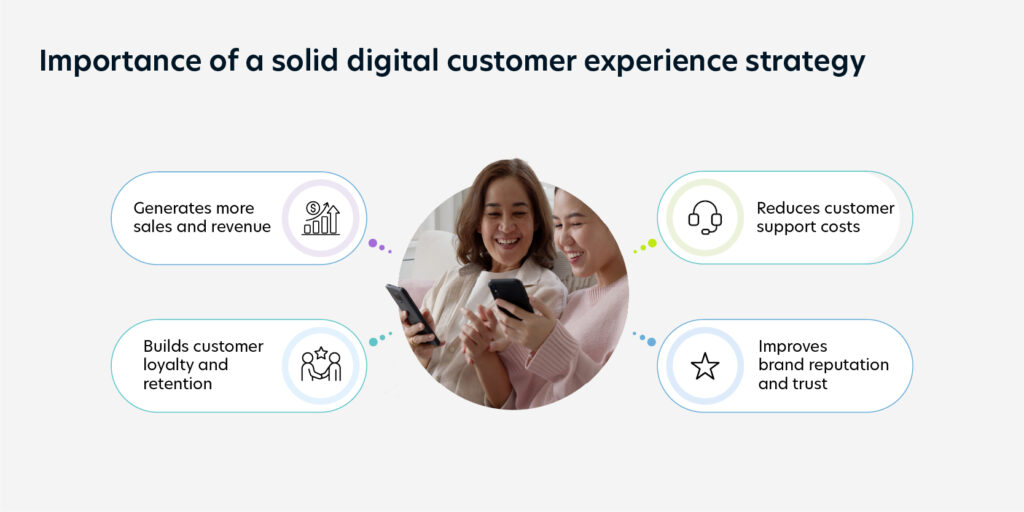In today’s competitive landscape, where 89% of businesses prioritize customer experience, the focus extends beyond product and price. It revolves around the memories, emotions, and relationships fostered by a brand, largely influenced by digital interactions.
As companies ponder the definition of a customer experience strategy, it becomes evident that digital interactions play a crucial role in shaping brand image. The ability to understand, anticipate, and fulfil customer needs has a direct impact on brand loyalty, customer retention, and overall business success.
To achieve this, organizations must adopt comprehensive strategies and best practices that prioritize the customer journey at every touchpoint. In this blog, we’ll explore the essential strategies that businesses must embrace to succeed in improving and delivering seamless customer experiences.
Crafting an Impactful Digital Customer Experience Strategy
Businesses today are presented with an unprecedented opportunity to connect with their customers on digital platforms, providing seamless, personalized, and engaging experiences that resonate with modern consumers. Crafting an impactful digital customer experience strategy is not merely a choice but a necessity for organizations striving to thrive in the digital landscape.

Here are few practices that businesses can follow to formulate a customer-centric strategy that harnesses the power of digital channels to drive meaningful and enduring connections with customers.
1. Data-Driven Customer Understanding in Digital Customer Experience Strategy
To craft a successful Digital Customer Experience (DCX) strategy, start with thorough research and data gathering. Utilize diverse sources like market research, customer feedback, and social media analytics. This comprehensive approach provides invaluable insights into your customer base.
Next, create detailed customer personas based on this wealth of information. Each persona should vividly represent different audience segments, including preferences, behaviors, pain points, and digital habits. Tailoring your DCX strategy to these personas ensures it effectively meets the unique needs of each customer segment.
2. Map the Customer Journey
To create a strong Digital Customer Experience Strategy, first, identify all digital touchpoints where customers engage with your brand, such as your website, social media, email, apps, and ads. Then, analyze customer journey maps to understand their navigation path, highlighting both positive experiences and challenges. This insight into customer behavior enables you to enhance their experience across all digital platforms.
3. Set Clear Objectives
Align your Digital Customer Experience (DCX) strategy with your business goals. Set measurable objectives like boosting sales or improving customer retention. Clear goals help gauge the success of your DCX strategy and its impact on overall business outcomes.
4. Embracing New Technologies in Your Digital Customer Experience Strategy
To enhance your Digital Customer Experience (DCX) strategy, begin by assessing your current digital tools and platforms, including CRM systems, marketing automation tools, analytics software, and customer service platforms. Identifying existing gaps is essential for refining your overall digital customer experience.
Additionally, it’s vital to stay updated on emerging technologies that can transform the digital experience. Innovations like AI, chatbots, and AR/VR are revolutionizing customer interactions, offering immersive experiences and deeper engagement. Integrating these technologies into your DCX strategy ensures a modern approach and enhances customer satisfaction.
5. Design Engaging and Personalized Experiences
A successful Digital Customer Experience (DCX) strategy centers on user-centric design, emphasizing usability, accessibility, and aesthetic appeal for intuitive and engaging digital platforms. Personalization is equally vital, catering to individual preferences and past interactions. Studies show personalized experiences increase purchase likelihood by 80%, highlighting their importance in enhancing engagement and conversion rates.
6. Fostering Engagement Through Content and Community in Your Digital Customer Experience Strategy
Crafting relatable content and fostering a vibrant brand community are key elements of a successful Digital Customer Experience (DCX) strategy. Engage customers through emotional storytelling and create spaces on social media for interaction. These practices deepen customer engagement and cultivate stronger brand relationships.
7. Integrate Across Channels
Adopting an omni-channel approach is essential for a successful Digital Customer Experience (DCX) strategy. Customers expect consistency across all digital touchpoints, from apps to social media. Hence, investing in omni-channel transformation can boost customer satisfaction and can increase revenue growth by 5 to 15%. Additionally, maintaining consistent messaging reinforces brand identity and builds trust with your audience, ensuring a cohesive and satisfying customer experience across platforms.
8. Prioritize Customer Feedback and Adaptation
Continuous collection and analysis of customer feedback across digital channels are fundamental to a strong Digital Customer Experience (DCX) strategy. This ongoing feedback loop provides invaluable insights into customer needs and perceptions, enabling businesses to make informed decisions. Additionally, responsiveness to feedback and market trends ensures that the DCX strategy remains dynamic and aligned with evolving customer expectations, facilitating continuous improvement and adaptation.
9. Implement and Monitor
A vital component of an effective Digital Customer Experience (DCX) strategy is crafting a comprehensive action plan. This plan delineates implementation steps, timelines, and assigned responsibilities, ensuring systematic execution. Additionally, regular performance monitoring is crucial. By measuring outcomes against predefined goals using key metrics and analytics, you can identify successes and areas for improvement. This ongoing evaluation enables strategy refinement, ensuring alignment with objectives and responsiveness to customer needs and market changes.
10. Sustaining and Improving Your Strategy for Digital Customer Experience
To sustain the success of your Digital Customer Experience (DCX) strategy, regular reviews are imperative. These assessments focus on evaluating strategy effectiveness, identifying areas for improvement, and aligning with customer expectations and business goals. Embracing a culture of continuous improvement is equally crucial. Adapting to evolving digital trends, customer feedback, and analytical insights ensures strategy relevance and competitiveness, enhancing the overall customer experience.
Final Thought
An integral component of a successful Digital Customer Experience (DCX) strategy is harmonizing customer experience with customer success and support. This cohesive integration ensures meticulous consideration and optimization of every customer interaction with the brand, resulting in a comprehensive and effective customer experience.
In conclusion, the landscape of Digital Customer Experience continues to evolve, shaped by technology and evolving consumer demands. At Quinnox, we pledge to lead this change, leveraging our proficiency in customer voice analytics to enable enterprises to craft outstanding digital experiences. By leveraging Quinnox’s proven methodologies and innovative technologies, businesses can elevate their customer experience initiatives and achieve tangible results in customer satisfaction and business growth.
Explore more on elevating your customer experience journey!



